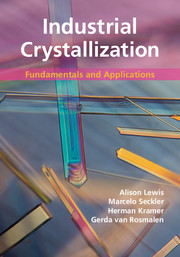Book contents
- Frontmatter
- Contents
- Nomenclature
- Industrial crystallization in practice: from process to product
- 1 Thermodynamics, crystallization methods and supersaturation
- 2 Characterization of a crystalline product
- 3 Basic process design for crystallization
- 4 Nucleation
- 5 Crystal growth
- 6 Agglomeration
- 7 The population balance equation
- 8 Batch crystallization
- 9 Measuring techniques
- 10 Industrial crystallizers
- 11 Precipitation and anti-solvent crystallization
- 12 Melt crystallization
- 13 Additives and impurities
- 14 Polymorphism
- Index
- References
3 - Basic process design for crystallization
Published online by Cambridge University Press: 05 July 2015
- Frontmatter
- Contents
- Nomenclature
- Industrial crystallization in practice: from process to product
- 1 Thermodynamics, crystallization methods and supersaturation
- 2 Characterization of a crystalline product
- 3 Basic process design for crystallization
- 4 Nucleation
- 5 Crystal growth
- 6 Agglomeration
- 7 The population balance equation
- 8 Batch crystallization
- 9 Measuring techniques
- 10 Industrial crystallizers
- 11 Precipitation and anti-solvent crystallization
- 12 Melt crystallization
- 13 Additives and impurities
- 14 Polymorphism
- Index
- References
Summary
Why this chapter is important
This chapter discusses the basic design of industrial crystallizers. The major design tasks are the selection of the crystallization method, the crystallizer equipment and the mode of operation, the calculation of the flow sheet of the process and of the dimensions of the equipment, the area for heat transfer and evaporation, and the power requirement for the circulation devices. With the help of a costing model, the basic design also yields a first cost estimate of the process in terms of both capital and operational costs.
The method described in this chapter has been developed and tested for evaporative and cooling crystallization processes, but can be adapted relatively easily for melt crystallization processes from suspensions. Examples are given for evaporative and cooling processes, for a DTB evaporative crystallizer including mother liquid recycling and for an Oslo evaporative crystallizer.
The proposed procedure does not include a detailed design, in which not only the average particle size and purity have to be assured, but also the size distribution, the particle shape and degree of agglomeration, among other features that are specific to each application. In those circumstances, a detailed design procedure has to be followed that is based on a model for the industrial crystallizer that takes into account a number of compartments and the crystallization kinetics for the system of interest, followed by model validation in a pilot unit.
The basic design procedure
A hierarchical detailed design procedure has been proposed (Bermingham et al., 2000, Kramer et al., 1999) based on the pioneering work of Douglas (1985) with focus on a precise prediction of the final product quality through detailed mathematical modeling of the crystallization phenomena. Although this approach is suitable for consistent and reproducible design, it requires detailed knowledge of the kinetics and the hydrodynamics of the process, as well as substantial computing and experimental facilities. In Chapter 7 the detailed modeling needed to describe the product quality is discussed.
- Type
- Chapter
- Information
- Industrial CrystallizationFundamentals and Applications, pp. 51 - 70Publisher: Cambridge University PressPrint publication year: 2015



